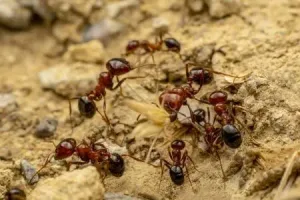Where Are Fire Ants Most Common?
Are you wondering where are fire ants most common? Then, you’ve spotted mounds popping up after a warm rain. In the U.S., red imported fire ants (RIFA, Solenopsis invicta) are most common across the southern states, thriving from Texas through the Deep South and throughout Florida.
Typical Places You’ll Find Fire Ants
 Fire ants love open, sunny, disturbed ground where they can easily create a massive underground colony. That’s why you see them in places people use every day such as lawns, parks, athletic fields, schoolyards, golf courses, and other turf areas. The ants also frequently move into pastures, crop fields, and meadows, where their mounds can damage equipment and create trip hazards for horses and humans alike. In urban and suburban settings they nest along sidewalks, medians, roadside shoulders, and near irrigation, taking advantage of the warm soil and steady moisture they can gain from such locations.
Fire ants love open, sunny, disturbed ground where they can easily create a massive underground colony. That’s why you see them in places people use every day such as lawns, parks, athletic fields, schoolyards, golf courses, and other turf areas. The ants also frequently move into pastures, crop fields, and meadows, where their mounds can damage equipment and create trip hazards for horses and humans alike. In urban and suburban settings they nest along sidewalks, medians, roadside shoulders, and near irrigation, taking advantage of the warm soil and steady moisture they can gain from such locations.
In Florida, fire ants can be sneaky: our sandy soils sometimes hide the classic tall mound you might expect in clay-heavy states. Instead, colonies may create a mound that is spread under thatch or they will build the mound lower and broader. In the Sunshine State, even a small mound can be heavily infested with fewer obvious “peaks.” They also form colonies within tree bases, stumps, landscape beds, and voids under pavement or structures. They are even known to invade electrical boxes and equipment.
Why They’re So Widespread in the South
Two big reasons why fire ants are so widespread in the south: climate and disturbance. Fire ants prefer warm temperatures and survive best where winters are mild. In addition, the Southeast’s long growing season and frequent soil disturbance (construction, landscaping, agriculture) create habitat they can colonize quickly. That’s why the current federal quarantine areas are concentrated across the southern tier and Florida, with additional counties added as detections expand.
Hotspots on Large Properties
- Athletic & Recreation Areas: Fire ants love large, open turf. Such areas give fire ants exactly what they want, ample sun and space. Expect to see ant activity near sidelines, dugouts, bleachers, and irrigation heads, and along fence lines and utility housings.
- HOAs, Resorts & Campuses: Common lawns, playgrounds, mail kiosks, and trail edges are regular targets for ant colonies. This is especially true where mulch and drip lines provide warm, moist micro-sites.
- Horse Farms & Pastures: Sunny, grazed ground is prime habitat for fire ants. Unfortunately, the mounds can cause hoof injuries and equipment issues if left unchecked.
- Industrial & Retail Sites: Perimeters, trucking lanes, and landscape islands offer disturbed soil and heat from pavement which is all great for nesting ants but bad for operations.
Seasonality: When Activity Peaks
While colonies persist year-round in Florida, you’ll typically notice the most mound-building after warm rains and during the spring and fall months when soil moisture and temperatures favor foraging. During extreme heat or drought, colonies may go deeper underground, making mounds less obvious, even as populations remain high within the colony.
What To Do If Your Site Is a Magnet
Because most of the colony is underground, spot-spraying visible workers rarely solves the problem. USDA guidance emphasizes area-wide baiting as the most effective, efficient ant killing strategy for large landscapes. Workers carry granular bait back to the nest, targeting the queen so the colony collapses over its life cycle.
Service in Southwest & Central Florida
Fire Ant Control, LLC treats large residential and commercial properties, including parks, recreation areas, school grounds, HOAs, horse farms, and pastures, with professional broadcast applications designed for acreage.
On-site fire ant treatment is available in these Florida counties: Lee, Hillsborough, Polk, Manatee, Hardee, Desoto, Sarasota, Charlotte, Glades, Hendry, and Collier.
Ready for Fewer Mounds and Safer Grounds?
If you’re still wondering where are fire ants the most common? Then please take a look around your landscape for mounds that could indicate fire ant colonies. If your property sits in a hotspot of fire ant activity and you’re seeing activity in any of the areas above, we can help. Schedule a consultation with Fire Ant Control, LLC to map out an area-wide broadcast plan that keeps people, pets, turf, and equipment safe for season after season. We serve commercial sites and large residential properties across our Florida service area.
